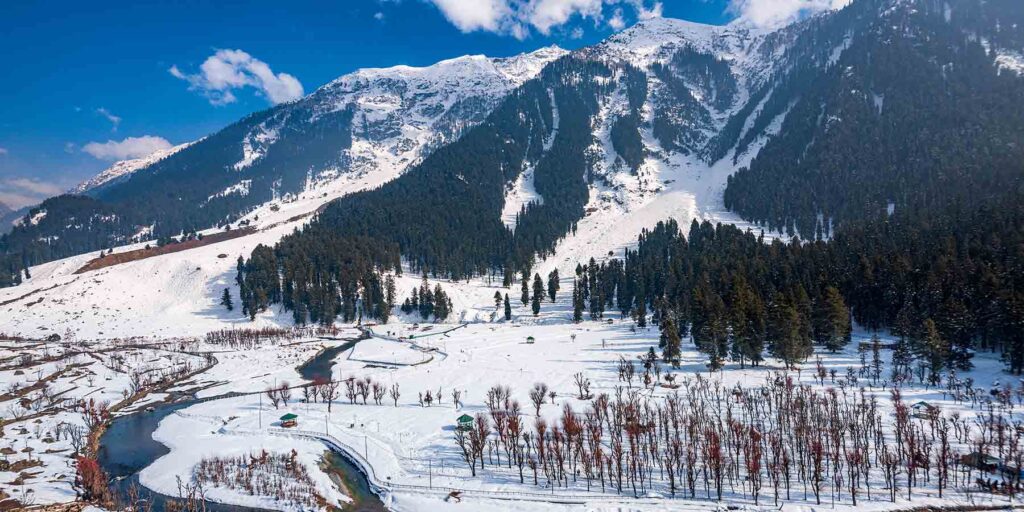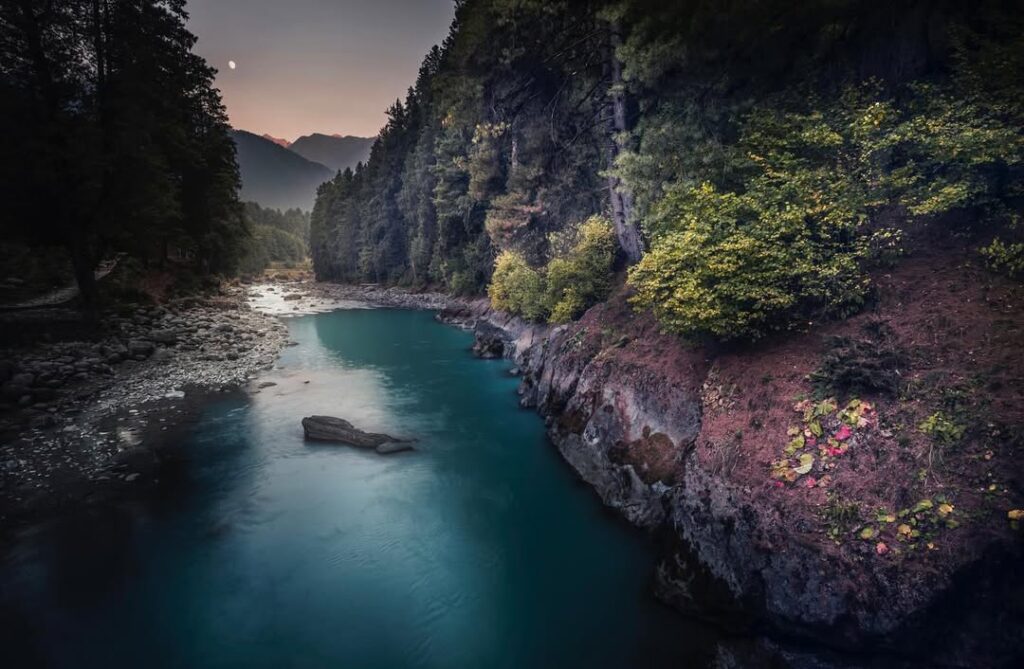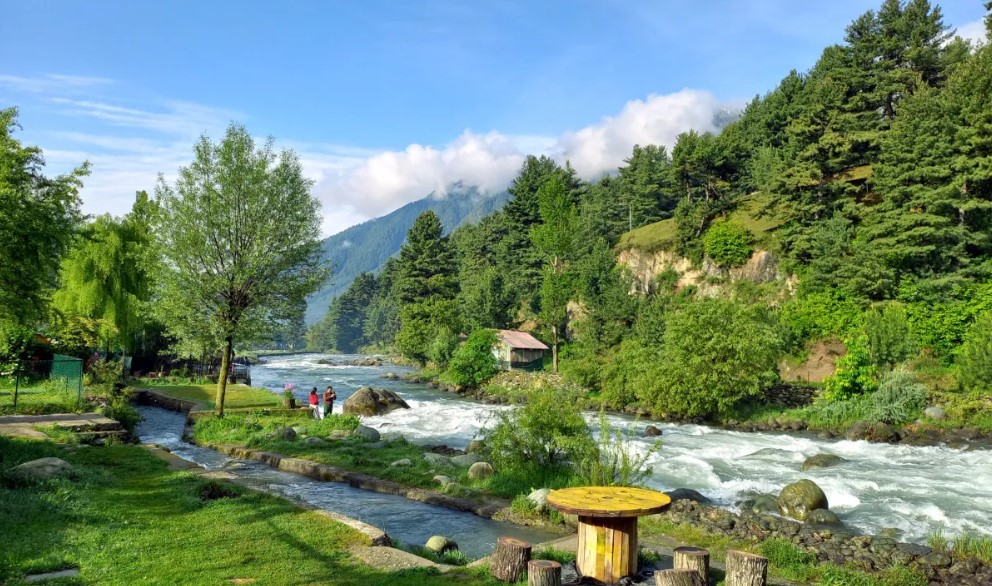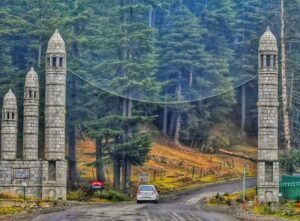Betaab Valley’s name has a backstory; we called it Hagan Valley in my childhood. This name passed through generations of my Kashmiri ancestors. I remember vividly when film crews arrived with cameras and famous actors. Subsequently, they transformed our quiet meadow into something that would captivate all of India.
The valley sits near my hometown of Pahalgam and has been part of our daily lives for centuries. Initially, shepherds grazed their flocks here. Meanwhile, locals escaped here during hot summer afternoons. However, everything changed dramatically in 1983 when the Bollywood film “Betaab” was shot here. The film notably starred newcomers Sunny Deol and Amrita Singh.
The film captured our valley with deep affection. As a result, audiences across India fell under its spell. Tourists began arriving soon after, frequently asking for “that Betaab film location.” Within a few years, consequently, official maps changed too. Thus, Hagan Valley became Betaab Valley, and our local treasure transformed into a national icon.
I’ve watched the valley through all seasons and changes. Interestingly, the renaming wasn’t something we locals resisted. Instead, we feel pride seeing our home through others’ admiring eyes. After all, the film captured the essential magic we’ve always known existed here.
Local Insights About Betaab Valley
Did you know? Betaab Valley served as our community grazing ground before attracting tourists. In fact, my grandfather took his sheep here during summer months. Additionally, the bend in the Lidder River that tourists photograph was especially special. Furthermore, women from neighboring villages gathered here to wash special garments before weddings because the water was believed to bring good fortune to new marriages.
Best time to visit: Mid-May is ideal. During this time, the nalah (stream) carries the first snowmelt. Additionally, pink Kashmiri roses bloom along the valley edges. Therefore, come around 7 AM when the morning light creates what we call “sheen-roath” (golden veil) across the meadows. Unfortunately, most tourists miss this magical sight by arriving too late.
What Makes Betaab Valley a Must-Visit Kashmir Treasure

We Kashmiris have a saying: “If Paradise had a courtyard, it would certainly be Betaab Valley.” While travelers rush to famous gardens like Nishat or Shalimar, we locals treasure this valley for its untamed authenticity mixed with accessible beauty.
When you step into Betaab Valley, you enter a perfectly balanced world. Notably, the grassy meadows aren’t ordinary lawns. Rather, they’re carpeted with medicinal herbs that we harvest in late spring. These include the precious “soi” (nettle) that consequently flavors our traditional tea. Moreover, the vivid green comes from centuries of melting snow, which has deposited minerals that nourish the soil in ways scientists still study.
The Lifeblood of the Valley: The Lidder River
The Lidder River doesn’t merely flow through our valley. Instead, it shapes our lives fundamentally. Primarily, its waters determine when we plant crops. Meanwhile, its currents have carved unique rock formations that create natural pools where generations of Kashmiri children learned to swim. Furthermore, the river’s distinct sound embeds in our consciousness so deeply that many locals who move away report hearing it in their dreams.
Ancient Guardians: The Deodars of Betaab
Look carefully at the ancient deodars surrounding the valley. Some are over 600 years old! Interestingly, our elders can “read” these trees, noting how growth patterns mark years of abundance or hardship. Additionally, we collect their fallen cones during autumn for traditional medicinal preparations that treat everything from common colds to joint pain.
The mountains aren’t just a backdrop. In contrast, they’re our calendar and weather forecast. For instance, we know it’s time to prepare fields when the snow line reaches a certain point on Kolahoi Peak. Similarly, we know rain will arrive within hours when clouds gather around the middle of the mountain – a phenomenon we call “pahad ki pagri” (the mountain’s turban).
Hidden Medicinal Treasures
Did you know? Local shepherds have identified over 40 different medicinal herbs growing naturally in Betaab Valley. Specifically, my grandmother taught me to recognize “kwang” (wild onion) that grows near the river’s edge. Although tourists often overlook this plant, it features prominently in many traditional Kashmiri remedies for respiratory ailments. Moreover, knowledgeable elders still lead community herb-gathering expeditions each spring. Consequently, tourists can join if they inquire at the Pahalgam Cultural Center.
Best time to visit: Late afternoon visits (3-5 PM) during September are ideal. During this time, the valley floor turns golden with autumn light. Additionally, the chirping of cicadas creates what we call “wanwun”—nature’s evening music. Furthermore, elderly Kashmiris often come to sit by the river during this time, sharing stories passed down for generations. As a result, visitors who approach respectfully are often welcomed into these gatherings.
How to Reach the Picturesque Betaab Valley With Ease
Location and Cultural Landmarks
Location: Betaab Valley lies about 7-8 kilometers from central Pahalgam. Specifically, it sits along what we locals call “yatra road” since it eventually leads to the holy Amarnath cave. Moreover, the journey itself forms part of the experience as you’ll pass through my community’s apple orchards and walnut groves.
Many tourists rush straight to the valley. Consequently, they miss the cultural landmarks along the way. For instance, notice the traditional wooden mosques with their distinctive spires as you travel from Pahalgam. Some, in fact, date back 400 years. Additionally, the third bridge you’ll cross has been rebuilt seven times due to floods, with each reconstruction featuring designs representing the governor of that period.
Transportation Options and Local Insights
Getting There: Tourist maps show this simply as the “Aru-Betaab-Chandanwari circuit.” However, each stretch of road has deep significance to us locals. For example, my great-grandfather’s generation carved this path by hand without modern equipment – an engineering feat that connected isolated mountain communities.
You’ll typically book a cab for the entire circuit at the Pahalgam taxi stand. Here’s an insider tip: Choose drivers who park at the eastern end of the stand near the old chinar tree. Generally, they come from families who have lived in these valleys for generations. As a result, these drivers will share stories and perspectives no guidebook can offer.
The circuit includes:
- Aru Valley (where my cousins still maintain traditional bee farms)
- Betaab Valley (the heart of our community gatherings)
- Chandanwari (not just the Amarnath Yatra starting point, but where our winter solstice celebrations occur)
While most tourists complete this circuit in a single day, we locals spend weeks exploring each valley’s hidden corners. Therefore, consider breaking your journey to experience the distinct character of each location.
Historical Significance of the Route
Did you know? The road to Betaab Valley follows an ancient trade route that once connected Kashmir to Central Asia. In fact, my ancestors transported Kashmir’s famous shawls and saffron to distant markets along this path. Furthermore, the large boulder marking the valley entrance bears inscriptions from travelers dating back to the 16th century. Additionally, ask your driver to show you where local children leave small flower offerings – a tradition that’s survived centuries of political changes.
Best time to visit: Come on a Thursday morning to experience Betaab Valley as we locals do. During this time, farmers from surrounding villages bring fresh produce to sell at the informal market just before the entrance. Consequently, you’ll find seasonal delicacies like fresh mulberries in May, wild apricots in June, and the sweetest apples in September. Moreover, vendors offer these with the traditional Kashmiri greeting “Aadaab” and often share stories of how the food was grown.
Unforgettable Experiences in the Magical Betaab Valley

My family experiences Betaab Valley differently than tourists do. Let me share our local perspectives and traditions to enrich your visit.
Embrace Tranquility in Betaab Valley’s Natural Setting
Tourists see picturesque meadows, but we see our heritage. For instance, the spot where most visitors take photographs is special because our village elders have gathered here for centuries to resolve community matters under the open sky. This tradition of “majlis-e-aam” (public assembly) continues informally today.
As you explore, notice areas where the grass grows in circular patterns. These mark spots where nomadic Gujjar families traditionally pitched tents during seasonal migrations. Although tourism has changed their routes, some families still pass through in early June and late September, bringing their distinctive music and artisan crafts.
I highly recommend finding a quiet spot near the eastern rock formations. Here, the valley’s natural acoustics create what we call “pahadon ki awaaz” (voice of the mountains). Remarkably, even whispers can be heard with clarity. Additionally, local musicians sometimes gather at dusk to play traditional Kashmiri instruments here, where the santoor and rabab sounds resonate perfectly with the valley’s natural features.
Traditional Practices and Healing Spots
My family has practiced “thankuni” for generations – a form of mindful sitting that connects one with nature’s elements. To experience this, find a flat rock near the river and sit cross-legged facing east. Then, spend seven minutes in silence. Consequently, you’ll understand why our poets refer to Betaab Valley as “sukoon ka ghar” (home of peace).
Did you know? The specific location where most tourists spread picnic blankets is especially special. Local healers consider it a healing spot because the soil contains trace minerals that create a natural magnetic field. Notably, our elders with arthritis would spend hours sitting directly on this ground, claiming more relief than from any medicine. While scientific studies remain inconclusive, many visitors report a subtle tingling sensation when walking barefoot through this section.
Best time to visit: Come during “waqt-e-sahar” (early dawn, around 5-6 AM) in late April or early October. During this time, local spiritual practitioners visit for meditation. Additionally, the valley often fills with a mystical morning mist we call “pari ka dupatta” (fairy’s veil). Therefore, maintain respectful silence if you arrive at this hour. As a result, you may receive an invitation to join in traditional morning tea prepared over small stone fire pits – an experience few tourists ever enjoy.
Capture Betaab Valley’s Cinematic Beauty
Secret Photography Spots Only Locals Know
Tourists typically photograph Betaab Valley from predictable angles. However, we locals know the secret spots that reveal the valley’s true character. For example, a narrow path through silver birch trees lies beyond the wooden bridge that features in every visitor’s album. This path leads to what we call “Chirag Point,” where the valley’s entirety unfolds in a panorama that changes dramatically with each hour of daylight.
For authentic photographs, look specifically for:
- The ancient walnut tree at the valley’s northeastern corner (estimated to be over 300 years old)
- The cluster of irises that bloom brilliantly in late May near the second wooden footbridge
- The natural rock formation we call “Sultan’s Throne”
- The reflection pools that form after rainfall
Professional Kashmiri photographers visit during “doodh wali roshni” (milky light) – a brief 15-minute period that occurs just after sunrise. During this magical time, mist clings to the valley floor while peaks shine in clear morning light, creating the layered effect seen in traditional Kashmiri paintings of the region.
Hidden Gems for Photography Enthusiasts
Did you know? Many tourists miss the hidden cave entrance on the valley’s western slope. A distinctive triangular rock marks it, and this small opening leads to what locals call “pari gufaa” (fairy cave). Interestingly, it contains limestone formations that glow with an ethereal blue light when photographed with long exposure. Furthermore, my grandfather told stories about this cave serving as a meeting place during resistance movements against various rulers throughout history. Although the inner chambers are now restricted, the entrance itself makes for a powerful photograph representing Kashmir’s resilient spirit.
Best time to visit: Come during “shafaq” (the moment between sunset and darkness) in mid-August for special photography. During this brief window, a phenomenon we call “doobti roshni” (sinking light) occurs, and the valley’s colors intensify dramatically for about 20 minutes. As a result, ordinary scenes transform into otherworldly landscapes. Therefore, bring a tripod and position yourself near the three sentinel stones at the valley’s western edge. Consequently, these compositions reveal why our poets call this place “jannat ka aks” (heaven’s reflection).
Experience the Lidder River’s Crystal Waters

The Lidder River isn’t merely scenery for us. In contrast, it’s a living entity that features prominently in our folklore, medicine, and daily life. While tourists see photo opportunities, I see the river that has sustained my community for countless generations.
Traditional Fishing and Cultural Practices
A specific bend in the river near the valley’s center has three distinctive white boulders. Here, my father taught me to fish using the traditional “gad-wan” technique, which involves using a handwoven willow basket to trap fish without harming smaller specimens that are released back into the water. You might spot local fishermen demonstrating this sustainable practice during summer mornings (typically 6-8 AM). Moreover, respectful visitors often receive invitations to try their hand, though mastering the technique requires years of practice.
You’ll notice smooth, flat stones arranged in semi-circles along the eastern bank. These are “dhobhi ghats”—traditional washing spots where community members still occasionally gather to clean special textiles like pashmina shawls that require gentle handling. Additionally, the river’s mineral composition makes it especially effective for cleaning without harsh chemicals.
Therapeutic Waters and Safety Considerations
For a truly local experience, look for spots where the river creates natural pools between rocks. These are “kanger kund” (warming pools) where the water temperature is slightly higher due to underground hot springs. Interestingly, local elders sometimes visit these spots during less crowded weekdays to ease joint pain—a therapeutic tradition dating back centuries.
Caution: The currents can be deceivingly strong, particularly during spring snowmelt. Therefore, we Kashmiris teach our children to respect the river’s power. Always test the current with a stick before entering and never venture beyond waist-depth because underwater currents can be stronger than surface movements suggest.
Mineral-Rich Waters with Healing Properties
Did you know? The distinctive blue-green color of the Lidder River comes from a unique mineral composition found nowhere else in Kashmir. Traditionally, our medicine practitioners collect specific river stones during the waning moon of June. These are subsequently ground into powder and used in treatments for skin conditions. Remarkably, scientific analysis has confirmed these stones contain unusual concentrations of copper and zinc. Additionally, local legend holds that drinking from a specific spring feeding into the river brings good fortune. As a result, many young Kashmiris still visit before important exams or life events. You can identify this spot by the circle of seven stones near the northern bridge that marks this spring.
Best time to visit: Experience the river as locals do during “dopahar ki sannata” (afternoon quiet) between 2-4 PM in late July. During this time, water levels stabilize and create gentle melodic sounds as currents pass over river stones. My grandmother taught me to “listen to the river’s stories” here – a meditative practice that involves distinguishing between different water sounds. In our tradition, we identify seven distinct water sounds—from “jharana” (waterfall melody) to “tapak” (droplet rhythm). Therefore, find a comfortable spot along the eastern bank, close your eyes, and practice listening for these sounds.
Essential Visitor Information for Betaab Valley Explorers
I’ve watched Betaab Valley transform from our local secret to a tourist destination. Consequently, let me offer information rarely found in guidebooks.
Entry Fees and Local Etiquette
Entry Fee (2025):
- Adults: Approximately INR 100 per person
- Children: Often half-price for those under 12 (enforcement varies)
- Camera Fee: Professional equipment incurs an additional charge of INR 50-100
Local insight: The ticket collectors usually come from nearby villages. Therefore, greet them with “Aadaab” or “Salaam Alaikum” rather than just handing over money. As a result, you’ll often receive helpful information about current conditions in the valley. Additionally, mentioning a famous Kashmiri poet like Mahjoor can lead to wonderful impromptu conversations if you’re genuinely interested in local culture.
Operating Hours and Insider Access
Timings:
- Official hours: 9:00 AM to 6:00 PM daily
- Summer extension: Hours often stretch to 7:00 PM during June-July
- Winter reduction: 9:00 AM to 5:00 PM during November-February
Local secret: The actual opening time is often earlier than posted during less busy seasons. For instance, it sometimes starts as early as 7:30 AM when the caretaker arrives. Moreover, a small token of appreciation (a packet of kahwa tea works well) can sometimes grant early access for photographers seeking morning light.
Amenities and Local Expertise
Facilities Available:
- Restrooms near entrance (simple but typically clean)
- Seating areas strategically placed throughout the valley
- Tea stalls operated by local families (seasonal)
- First aid station during peak season (staffed by volunteers from nearby villages)
Guidebooks don’t mention the elderly man who often sits near the eastern bridge. This is Rafiq Uncle, a retired botany teacher who can identify every plant species in the valley. Therefore, a respectful conversation with him will reveal secrets about local flora that no official guide mentions. While he prefers Kashmiri or Urdu, he speaks basic English as well.
Conservation Efforts and Authentic Souvenirs
Did you know? Locals established a community-based conservation group after tourism increased. Specifically, the “Betaab Bachao Samiti” (Save Betaab Committee) pioneered the valley’s zero-waste initiatives. Furthermore, the distinctive woven grass baskets used for trash collection are handmade by women from neighboring villages. These same women also create traditional Kashmiri handicrafts that you can purchase at the small cooperative shop near the exit. Consequently, this offers more authentic souvenirs than the tourist markets in Pahalgam, and proceeds support conservation efforts.
Best time to visit: Tuesday or Wednesday mornings around 10 AM in mid-May or late September are ideal. This timing helps you avoid weekend crowds. Additionally, you’ll experience the valley when maintenance crews (mostly local youth) have freshly prepared the grounds and pathways. Moreover, the light creates what we call “herath roshni” (divine light) during these months – a phenomenon photographers travel from across India to capture.
Community Activities and Recommended Visit Duration
Local Activities Tourists Can Join:
- Community Herb Walks: Every second Saturday of May and September
- Traditional Fishing Demonstrations: On summer weekday mornings
- Tea Making Sessions: During summer evenings (around 5 PM)
- Music Circles: Informal gatherings sometimes occur near sunset, particularly on full moon evenings
Time Required: While tourists typically allocate 1-1.5 hours, we locals often spend entire days here during special seasons. Therefore, set aside at least 3 hours if possible. This allows you to experience the valley’s changing moods as the sun moves across the sky. As a result, those who stay from early morning to sunset often report feeling they’ve visited multiple places rather than a single location.
Betaab Valley: The Crown Jewel in Pahalgam’s Sightseeing Circuit
We Kashmiris view Betaab Valley as one element in a sacred geography. Specifically, the Aru-Betaab-Chandanwari circuit isn’t merely a tourist route. Instead, it represents the three aspects of our homeland’s character.
The Cultural Significance of the Three Valleys
In our cultural understanding:
- Aru embodies “jazbaat” (emotion)—wild, untamed, representing Kashmir’s passionate heart
- Betaab Valley embodies “sukoon” (peace)—balanced, harmonious, representing Kashmir’s spiritual center
- Chandanwari embodies “quwwat” (strength)—rugged, enduring, representing Kashmir’s resilience
This explains why we locals recommend experiencing all three locations. By doing so, you can truly understand Kashmir’s soul. In fact, I teach my own children how these three places mirror our people’s character when taking them on this circuit. After all, we are capable of both gentle beauty and surprising strength.
A Local’s Recommended Itinerary
The typical tourist taxi route follows logistics rather than cultural significance. Therefore, consider this local approach instead:
- Begin at Chandanwari early morning to witness the sunrise
- Proceed to Betaab Valley mid-day for balanced harmony
- End at Aru for emotional sunset splendor
This sequence follows the traditional Kashmiri understanding of life’s journey as it moves from struggle to peace to transcendence.
The Ancient Path of Prosperity
Did you know? The specific road connecting these three locations follows what we call “raasta-e-rifah” (path of prosperity). This ancient trade route once connected different ecological zones of Kashmir. Moreover, local farmers still use portions of the original footpath to move livestock between seasonal pastures, which are visible from certain bends in the modern road. Additionally, the distinctive rock cairns along these paths aren’t random. Instead, they mark traditional rest points where travelers have paused for centuries. According to folklore, adding a stone to these cairns brings good fortune for your journey.
Best time to visit: Choose early June to experience this circuit as locals do. During this time, rhododendrons bloom across all three valleys in slightly different schedules due to elevation differences. This creates what we call “gulabi safar” (rosy journey) as you travel from one flowering landscape to another. Therefore, begin at dawn in Chandanwari, reach Betaab Valley by mid-morning, and end in Aru by late afternoon. This approach follows the natural progression of how these flowers open throughout the day.
Why Betaab Valley Remains Kashmir’s Most Beloved Home

I was born under the same mountains that watch over Betaab Valley. Throughout my life, I’ve witnessed its transformation from our community’s private heaven to a place shared with the world. Nevertheless, the valley’s essential spirit remains despite the changes tourism brings. Indeed, it perfectly expresses what makes our Kashmir “jannat-e-benazir” (paradise unequaled).
When you visit Betaab Valley, you’ll experience more than scenic beauty. Instead, you’ll encounter the living heart of Kashmir’s identity. Tourists now spread picnic blankets on the same meadows where my grandfather taught me our folk dances. Similarly, the river that provides perfect photographs has also provided life to my community for generations. Furthermore, the mountains that frame your vacation snapshots have shaped our collective character through centuries.
We Kashmiris have a saying: “Har kashmiri ke dil mein Betaab basta hai” (Betaab Valley dwells in every Kashmiri heart). Therefore, when you visit, you’re not just seeing a famous film location or natural wonder. Rather, you’re experiencing a place that represents who we are as a people: resilient yet gentle, dramatic yet peaceful, ancient yet ever-renewing.
As you plan your journey, remember that Betaab Valley isn’t merely a destination. Instead, it’s an invitation into our world. Consequently, come not just as a visitor but as a temporary member of our extended family. Sit by our river, walk our ancient paths, and breathe our mountain air. Perhaps, for a moment, you’ll see Kashmir through Kashmiri eyes.
We believe that those who have truly experienced Betaab Valley carry a piece of Kashmir with them forever. Similarly, we locals carry the valley in our hearts even when far from home. This is, ultimately, the magic of Betaab Valley – it doesn’t just offer views, but rather, it offers belonging.



